Papers by Rainer Sauerborn

International Journal of Health Planning and Management, 2003
The objectives of this study were to describe the cost distribution of pneumonia treatment in ter... more The objectives of this study were to describe the cost distribution of pneumonia treatment in tertiary hospitals in the National Capital Region (NCR) and to identify variations in costs in order to provide basic information to the Philippine Health Insurance Corporation (PHIC) for quality assurance and policy development. This study focuses on 3861 reimbursement claims, which come from 22 government and 38 private tertiary hospitals. Wide variations of cost existed among the hospitals and among the inpatients. Medicine was the leading expenditure in total costs (38%), second was examinations (27%), third was beds (22%) and the last was doctors fees (13%). The same ranking ocurred for reimbursement by PHIC. The private hospitals were more expensive than the government hospitals, but also more efficient in the length of hospitalization. The member patients spent more and were reimbursed more for clinical practice than the dependent patients. However, there was no difference in the length of hospitalization between member and dependent patients. There was no difference in the length of hospitalization and expenditure between Government Service Insurance System (GSIS) in 1997 and Social Security System (SSS) patients. Clinical guidelines should be effectively implemented and PHIC should contribute more to reduce existing variations, improve cost-effectiveness and the quality of clinical practices.

Global Health Action, 2015
Micro health insurance schemes have been implemented across developing countries as a means of fa... more Micro health insurance schemes have been implemented across developing countries as a means of facilitating access to modern medical care, with the ultimate aim of improving health. This effect, however, has not been explored sufficiently. We investigated the effect of enrolment into community-based health insurance on mortality in children under 5 years of age in a health and demographic surveillance system in Nouna, Burkina Faso. We analysed the effect of health insurance enrolment on child mortality with a Cox regression model. We adjusted for variables that we found to be related to the enrolment in health insurance in a preceding analysis. Based on the analysis of 33,500 children, the risk of mortality was 46% lower in children enrolled in health insurance as compared to the non-enrolled children (HR=0.54, 95% CI 0.43-0.68) after adjustment for possible confounders. We identified socioeconomic status, father's education, distance to the health facility, year of birth, and insurance status of the mother at time of birth as the major determinants of health insurance enrolment. The strong effect of health insurance enrolment on child mortality may be explained by increased utilisation of health services by enrolled children; however, other non-observed factors cannot be excluded. Because malaria is a main cause of death in the study area, early consultation of health services in case of infection could prevent many deaths. Concerning the magnitude of the effect, implementation of health insurance could be a major driving factor of reduction in child mortality in the developing world.
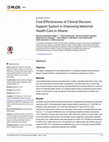
PloS one, 2015
This paper investigated the cost-effectiveness of a computer-assisted Clinical Decision Support S... more This paper investigated the cost-effectiveness of a computer-assisted Clinical Decision Support System (CDSS) in the identification of maternal complications in Ghana. A cost-effectiveness analysis was performed in a before- and after-intervention study. Analysis was conducted from the provider's perspective. The intervention area was the Kassena- Nankana district where computer-assisted CDSS was used by midwives in maternal care in six selected health centres. Six selected health centers in the Builsa district served as the non-intervention group, where the normal Ghana Health Service activities were being carried out. Computer-assisted CDSS increased the detection of pregnancy complications during antenatal care (ANC) in the intervention health centres (before-intervention= 9 /1,000 ANC attendance; after-intervention= 12/1,000 ANC attendance; P-value=0.010). In the intervention health centres, there was a decrease in the number of complications during labour by 1.1%, though th...

Transactions of the Royal Society of Tropical Medicine and Hygiene, 2010
The risk of malaria can be influenced by the household environment. The range of these risks can ... more The risk of malaria can be influenced by the household environment. The range of these risks can be more diverse in semi-urban areas, which can include a mix of different housing styles and environments. This study examined the effect of different housing and household characteristics on malaria risk among 98 case and 185 control children in the semi-urban area of Nouna, Burkina Faso. Characteristics were assessed via questionnaires and direct inspection. Those characteristics associated with a decreased risk of malaria were floors constructed of earth bricks and running water in the neighbourhood. Electrification of the home and house age of <10 years were associated with an increased risk of malaria. The findings of this study suggest that modification of the household environment could be a feasible way to reduce the risk of malaria, particularly in semi-urban areas.

Scandinavian journal of public health, 2005
This study aims to set priorities for anti-disease malaria vaccines by determining community pref... more This study aims to set priorities for anti-disease malaria vaccines by determining community preference in a hyperendemic area. A bidding game technique was used to elucidate willingness to pay in rural Burkina Faso and 2,326 adults were interviewed. It is shown that there are significant differences between community preference for an anti-disease vaccine aimed at reducing pathology in pregnant women, and for a vaccine directed against childhood malaria. While the target population was willing to pay CFAfr 2101 for a vaccine against maternal malaria, its members were prepared to pay only CFAfr 1433 for a vaccine against childhood malaria. Whilst it is increasingly likely that anti-disease malaria vaccines will become available in the foreseeable future, lessons from the past suggest that a lack of acceptance and support from the intended recipients may lead to less than optimal compliance, and hence efficacy. For the planning of vaccine development and application strategies, it is...
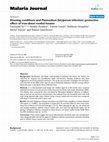
Malaria journal, 2006
Identification and better understanding of potential risk factors for malaria are important for t... more Identification and better understanding of potential risk factors for malaria are important for targeted and cost-effective health interventions. Housing conditions have been suggested as one of the potential risk factors. This study aims to further investigate this risk factor, and is focused on the effect of the type of roof on Plasmodium falciparum infection among children below five years in the North West of Burkina Faso. In a cross-sectional study design, 661 children aged six to 60 months were randomly selected from three rural and one semi-urban site at the end of the rainy season (November 2003). The children were screened for fever and tested for Plasmodium falciparum infection. In addition, data on bed net use and house characteristics was collected from the household were each child lived. Using adjusted odds ratios, children living in house roofed with iron-sheet were compared with those in house with mud or grass roof. Overall P. falciparum infection prevalence was 22....
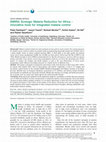
Global health action, 2014
Malaria control is based on early treatment of cases and on vector control. The current measures ... more Malaria control is based on early treatment of cases and on vector control. The current measures for malaria vector control in Africa are mainly based on long-lasting insecticide treated nets (LLINs) and to a much smaller extent on indoor residual spraying (IRS). A third pillar in the fight against the malaria vector, larval source management (LSM), has virtually not been used in Africa since the ban of DDT in the 1960s. Within the light of recent WHO recommendations for Bacillus thuringiensis israelensis (Bti) use against malaria and other vector species, larval source management could see a revival in the upcoming years. In this project we analyze the ecologic and health impacts as well as the cost effectiveness of larval source management under different larviciding scenarios in a health district in Burkina Faso. The project is designed as prospective intervention study with duration of three years (2013-2015). Its spatial scale includes three arms of interventions and control, c...
Tropical Medicine & International Health, 2002
OBJECTIVE OBJ ECTIVE To examine household out-of-pocket expenditure on health care, particularly ... more OBJECTIVE OBJ ECTIVE To examine household out-of-pocket expenditure on health care, particularly malaria treatment, in rural Burkina Faso. METHOD METHO D Comprehensive analysis of out-of-pocket expenditure on health care through a descriptive analysis and a second, multivariate analysis using the Tobit model with emphasis on malaria, based on 800 urban and rural households in Nouna health district.

Social Science & Medicine, 2003
The test-retest reliability of the bidding game and the take-it-or-leave-it (TIOLI) approaches to... more The test-retest reliability of the bidding game and the take-it-or-leave-it (TIOLI) approaches to eliciting willingness-to-pay (WTP) are compared. A random sample of households in the Nouna area of Burkina Faso were interviewed twice with an interval of around 4-5 weeks. One thousand one hundred and eight individuals were asked their individual WTP for community-based health insurance. Three hundred and forty eight of these individuals were household heads who were in addition asked about their WTP for health insurance for the whole household. Median and the mean WTP were higher in the test than in the retest. Despite these differences both methods displayed moderate to good reliability (kappa values ranged from 0.467 to 0.621, Spearman correlations ranged from 0.653 to 0.701 and Pearson correlations ranged from 0.593 to 0.675). There was some evidence that the bidding game was more reliable than the TIOLI method. This study is based on larger sample size than previous studies and also is one of the first studies of the reliability of WTP in a developing country.
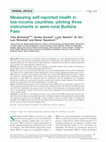
Global Health Action, 2012
Background: National surveys in low-income countries increasingly rely on self-reported measures ... more Background: National surveys in low-income countries increasingly rely on self-reported measures of health. The ease, speed, and economy of collecting self-reports of health make such collection attractive for rapid appraisals. However, the interpretation of these measures is complicated since different cultures understand and respond to the same question in different ways. Objective: The aim of this pilot study was to develop a culturally sensitive tool to study the self-reported health (SRH) of the local adult population in Burkina Faso. Design: The study was carried out in the 2009 rainy season. The sample included 27 men and 25 women aged 18 or older who live in semi-urban Nouna, Burkina Faso. Three culturally adapted instruments were tested: a SRH question, a wooden visual analogue scale (VAS), and a drawn VAS. Respondents were asked to explain their answers to each instrument. The narratives were analyzed with the content analysis technique, and the prevalence of poor SRH was estimated from the quantitative data by stratification for respondent background variables (sex, age, literacy, education, marital status, ethnicity, chronic diseases). The correlation between the instruments was tested with Spearman's correlation test. Results: The SRH question showed a 38.5% prevalence of poor SRH and 44.2% prevalence with both VAS. The correlation between the VAS was 0.89, whereas the correlation between the VAS and the SRH question was 0.60Á0.64. Nevertheless, the question used as the basis of each instrument was culturally sensitive and clear to all respondents. Analysis of the narratives shows that respondents clearly differentiated between the various health statuses. Conclusion: In this pilot, we developed and tested a new version of the SRH question that may be more culturally sensitive than its non-adapted equivalents. Additional insight into this population's understanding and reporting of health was also obtained. A larger sample is needed to further study the validity and reliability of the SRH question and the VAS and understand which instrument is best suited to study SRH in the low-income setting of semi-rural Burkina Faso.
Social Science & Medicine, 2002
A number of low and middle income countries (LMICs) are considering social health insurance (SHI)... more A number of low and middle income countries (LMICs) are considering social health insurance (SHI) for adoption into their social and economic environment or striving to sustain and improve already existing SHI schemes. SHI was first introduced in Germany in 1883. An analysis of the German system from its inception up to today may yield lessons relevant to other countries.

Global health action, 2014
Little research has focused on the economic hardship among the insured with severe illnesses and ... more Little research has focused on the economic hardship among the insured with severe illnesses and high treatment costs, in particular, the consequence of poorer insurance coverage for high-cost illnesses. Therefore, we presented the case for identifying the experiences of insured patients with severe chronic and acute illnesses. This study identified a qualitative understanding of the economic impact of severe chronic and acute illnesses and household strategies to deal with high treatment costs. Interviews were conducted with 19 insured households of three different health insurance programs with a family member that had been hospitalized for severe chronic or acute illnesses in either Banyumas or Margono Sukarjo hospitals in Banyumas, Central Java, Indonesia. A thematic analysis was applied to guide the interpretation of the data. Insured households with a family member that had been hospitalized for severe chronic and acute illnesses were greatly affected by the high treatment cos...
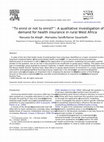
Social Science & Medicine, 2006
In spite of the fact that feeble levels of participation have long been identified as a major con... more In spite of the fact that feeble levels of participation have long been identified as a major constraint to the successful long-term implementation of community-based health insurance (CBI) in low-income countries, evidence on determinants of enrolment in CBI is still lacking. The application of econometric modelling has provided a partial answer to the question, but on its own it has proved to be insufficient to guide policy making. This paper aims to fill this gap in knowledge using qualitative research methods. In-depth interviews with 32 household heads were conducted in the Nouna Health District, Burkina Faso, West Africa to assess determinants of enrolment in a newly established CBI scheme. The findings highlight that factors previously neglected in the literature, such as institutional rigidities and socio-cultural practices, play an important role in shaping the decision to enrol. The discussion of the findings focuses on the policy implications, offering concrete recommendations to maximise enrolment, within and beyond Burkina Faso. r
Parasites & Vectors, 2008
Background Childhood mortality is a major public health problem in sub-Saharan Africa. For the im... more Background Childhood mortality is a major public health problem in sub-Saharan Africa. For the implementation of efficient public health systems, knowledge of the spatial distribution of mortality is required.
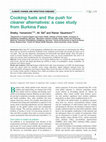
Global Health Action, 2009
Introduction: More than 95% of the population in Burkina Faso uses some form of solid biomass fue... more Introduction: More than 95% of the population in Burkina Faso uses some form of solid biomass fuel. When these fuels are burned in traditional, inefficient stoves, pollutant levels within and outside the home can be very high. This can have important consequences for both health and climate change. Thus, the push to switch to cleaner burning fuels is advantageous. However, there are several considerations that need to be taken into account when considering the use and promotion of different fuel types. Objective: In the setting of the semi-urban area of Nouna, Burkina Faso, we examine the common fuel types used (wood, charcoal and liquid petroleum gas (LPG)) in terms of consumption, energy, availability, air pollution and climate change. Results and conclusion: Although biomass solid fuel does offer some advantages over LPG, the disadvantages make this option much less desirable. Lower energy efficiencies, higher pollutant emission levels, the associated health consequences and climate change effects favour the choice of LPG over solid biomass fuel use. Further studies specific to Burkina Faso, which are lacking in this region, should also be undertaken in this area to better inform policy decisions.
Global Health Action, 2009
Health impacts of climate change and the need to prevent them should be at centre stage of the on... more Health impacts of climate change and the need to prevent them should be at centre stage of the ongoing debate on climate policies (1). We have specifically prepared this series of papers to be available for the COP15 1 conference in Copenhagen, to which the world looks to ...
Flugmedizin · Tropenmedizin · Reisemedizin - FTR, 2007











Uploads
Papers by Rainer Sauerborn